Search is changing faster than most marketers realise. In May 2025 alone, Perplexity processed about 780 million queries, and the company reported 20% month‑over‑month growth. Meanwhile, Google’s AI Overviews appear on about 13% of searches and correlate with a ~34,5% decline in click‑through rate. This shift isn’t just a quirk of user behaviour, it signals a structural change in how people find information.
Perplexity isn’t a typical search engine. It acts as a hybrid of search and conversational assistant, retrieving a curated set of trustworthy, up‑to‑date sources and synthesising them into concise answers. Unlike traditional search where ranking in the top few blue links is the goal, Perplexity surfaces three to five authoritative citations for each query. Winning visibility therefore means becoming one of those cited sources, not just ranking on a results page.
This matters today more than ever. While many businesses worry about declining traffic from ChatGPT (organic clicks from ChatGPT dropped 52% since July 2024), Perplexity referrals have grown 40% month-over-month. The platform is quickly becoming the preferred search tool for professionals, researchers and B2B decision‑makers. With billions of AI prompts happening daily across all large language models, securing a spot in Perplexity’s answer cards is a direct path to high‑intent visibility.
The bottom line is clear: citations are the new rankings. Brands that master Perplexity’s citation‑driven SEO today will capture disproportionate visibility tomorrow. The rest of this guide shows how to do it, by understanding Perplexity’s ranking signals, crafting content that earns citations, and building the technical and organisational foundation needed to thrive in the age of AI‑first search.
How Perplexity Works (Simplified + Technical View)
Perplexity positions itself as a cross between a search engine and a conversational assistant. Instead of indexing the entire web and returning pages ranked by keyword frequency, it crawls a curated set of trustworthy, up‑to‑date sources and then applies AI‑driven reranking to synthesise a short answer. When you ask a question, the system retrieves relevant documents, extracts key passages, and generates a concise response with inline citations. Those citations link back to the original sources, which is how brands gain visibility and traffic.
1. Core Principles: Authority, Recency and Citation Worthiness
Perplexity’s ranking is guided by three high‑level principles:
1. Authority over Volume – It prioritises sources with demonstrated expertise (credible publications, recognised authors) rather than content that merely matches keywords.
2. Recency Weighting – Fresh information carries more weight, especially on fast‑moving topics like technology and markets.
3. Citation Worthiness – The system implicitly asks: “Is this source worth citing in an academic paper?” Pages with original data, expert quotes and verifiable claims outperform generic listicles.
These principles are reinforced by operational signals: Perplexity updates its index daily, uses natural‑language understanding to interpret conversational queries, and favours multi‑format pages (text, video, infographics). Structured formatting, clear headings, bullet lists, tables and FAQ schemas, helps the model parse and summarise content.
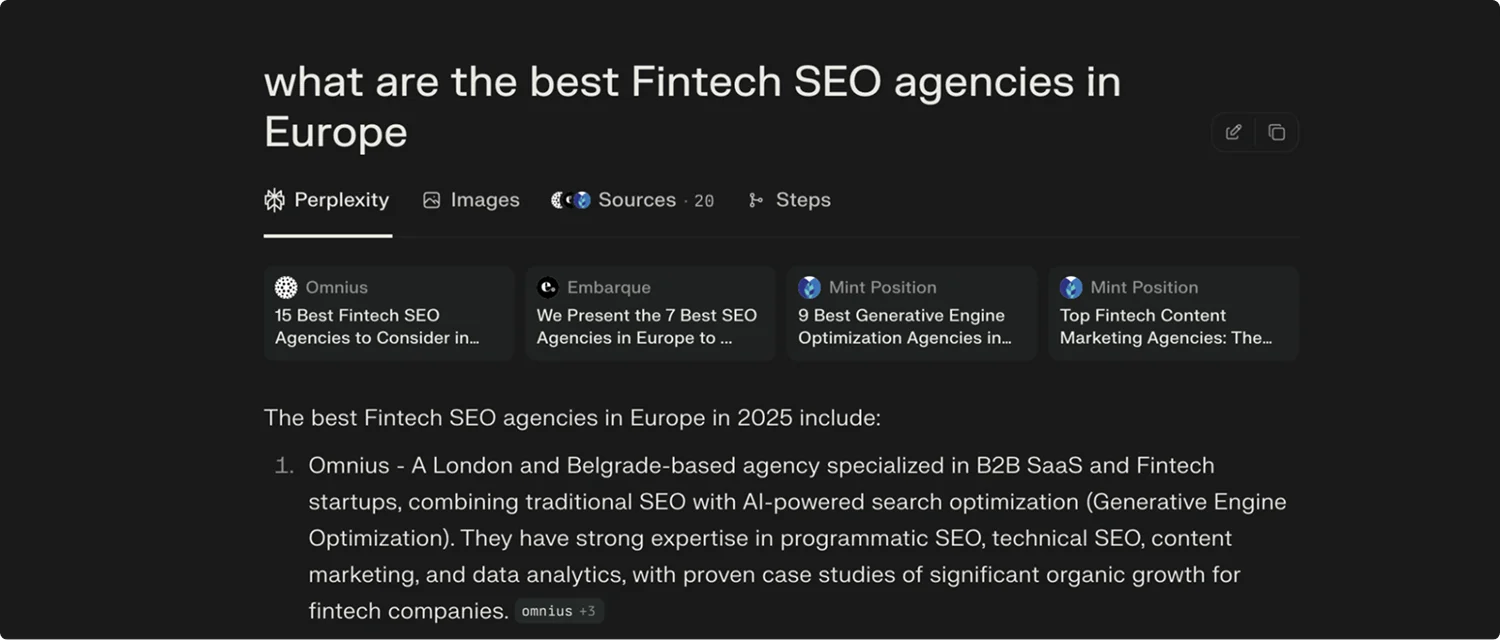
2. Retrieval & Reranking Mechanics (Reported)
While Perplexity hasn’t published its ranking algorithm, researchers and SEO practitioners have reverse‑engineered elements of its pipeline. According to a detailed analysis, Perplexity appears to run a multi‑stage retrieval and reranking process:
1. Initial retrieval: The system gathers candidate documents from its curated index based on semantic relevance and query intent.
2. Quality filtering (L3 reranker): A third‑layer reranker applies model‑based quality thresholds (e.g., l3_reranker_drop_threshold ) and may drop entire candidate sets if they don’t meet quality requirements.
3. Manual allowlists & blending: There are reports of curated domain groups that bias results toward high‑trust sites like Amazon, GitHub and official documentation. In parallel, a “blender” mechanism prevents any single domain from dominating the results by limiting web‑link percentages and balancing sources.
4. Embedding & semantic gating: A semantic similarity threshold ensures that only content closely aligned with the query and user profile passes the gate.
5. Engagement & feedback loops: Perplexity tracks user interactions (clicks, dislikes, no‑click behaviour) and adjusts visibility accordingly. It also boosts interlinked clusters of pages (memory networks) and monitors trending topics to adjust suggestions.
These reported parameters are not official documentation, but they offer a blueprint for understanding why certain pages earn citations while others don’t. They also highlight that Perplexity’s ranking is dynamic; factors like early engagement, topic multipliers and time decay influence how long a page remains visible (as we’ll explore in later sections).
By appreciating these underlying mechanics, both the transparent principles and the reverse‑engineered patterns, you can craft content and technical strategies that align with how Perplexity discovers and cites information.
Key Ranking Signals
Perplexity’s ranking system isn’t just a black box, it responds to a set of discernible signals. While the internal algorithms are proprietary, the following factors consistently emerge across research and practitioner reports.
1. Trust & Authority
Perplexity favours reputable, curated domains and recognised authorship. Pages published by subject‑matter experts or cited by established sources earn higher credibility. This extends beyond domain authority: the individual author’s credibility, visible through published work, professional profiles and industry recognition, also carries weight. Citing multiple high‑trust domains in your content further signals reliability.
2. Recency & Freshness
Freshness is a major differentiator. Perplexity updates its index daily and applies time‑decay mechanisms that rapidly reduce visibility if content isn’t refreshed. Timely updates, dated change logs and topical timeliness (e.g., publishing during a trend window) help pages remain eligible for Discover‑like surfaces.
3. Relevance & Semantic Quality
The system doesn’t rank pages based on keyword density; it gauges semantic alignment using embeddings. A reported parameter, embedding_similarity_threshold , acts as a quality gate: content must match the query conceptually and contextually. This favours entity‑rich language, thorough coverage of the topic and avoidance of keyword stuffing. Additionally, natural‑language queries require pages that directly answer questions and capture conversational phrasing.
4. Multi‑Format & Rich Media
Perplexity is not limited to text. Pages that blend text, videos, infographics or images are more likely to be cited, especially if the article is concise and includes embedded videos. New post thresholds reportedly reward cross‑channel synchronisation, such as coordinating YouTube video titles with trending queries. Here’s the list of top websites listed within AI responses by Perplexity, compared to ChatGPT:
5. Structured Content & Schema
Clear formatting helps the model parse content. Use descriptive headings, bullet lists, tables and FAQ sections. Implement schema markup for FAQs, How‑To guides, Products, Articles and Author profiles. Clean HTML and descriptive URLs also support crawlability and interpretation.
Tip: Use the Related section of Perplexity answers to generate Q&A ideas! This will help you identify new questions to answer in order to position yourself within the Perplexity - the same it is with the Featured Snipped Optimization in SEO.

6. Academic & Specialised Sources
For complex or professional queries, Perplexity cites peer‑reviewed or specialised publications. Including links to original research, official documentation and authoritative industry resources enhances citation potential.
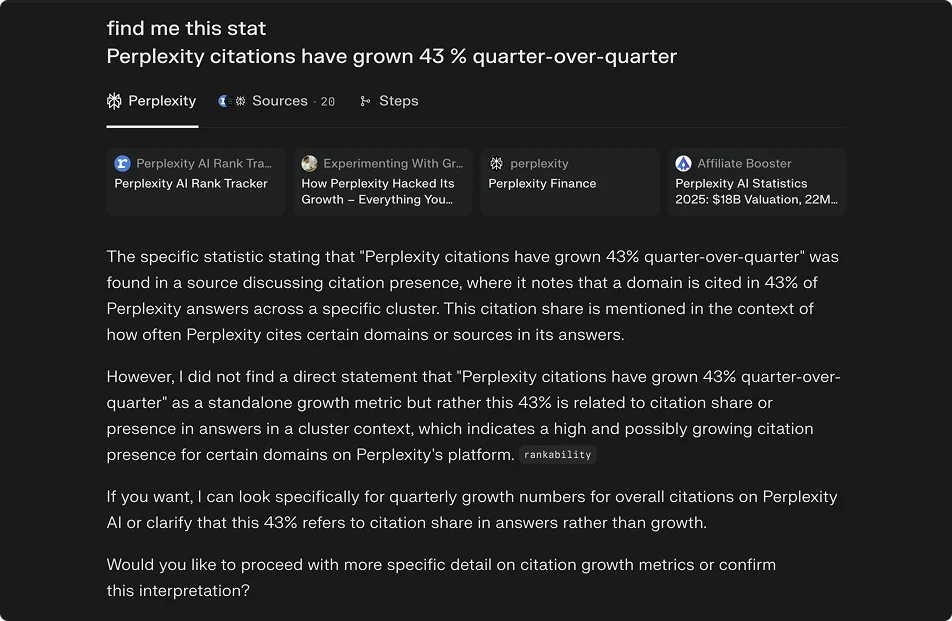
Content that reads like an expert report, with original data, benchmarks and verified claims, satisfies the algorithm’s “citation worthiness” test.
7. User Engagement Signals
Perplexity measures how users interact with answers. Engagement proxies such as click‑through rate, dwell time, and subsequent actions influence visibility. Conversely, negative signals, dislikes, or consistent “no‑click” behaviour, can suppress a page’s ranking. Designing for clarity (compelling titles, scannable intros) and providing genuinely useful answers helps attract clicks and reduce pogo‑sticking.
8. Negative Signals & Penalties
The ranking system includes filters to deter spam and low‑quality content. Reported parameters such as dislike_filter_limit and discover_no_click_7d_batch_embedding indicate that pages with high dislike rates or week‑long no‑click streaks may be demoted. Deduplication filters penalise near‑duplicate content, and a “blender” system prevents any single domain from monopolising citations. Maintaining content diversity (varied hashtags and outbound links) avoids triggering similarity or concentration thresholds.
Content Formats & Templates That Win Citations
Perplexity rewards content that answers questions succinctly yet comprehensively. The following formats, drawn from your documents, consistently earn citations.
1. Direct‑Answer Explainers (TL;DR + Evidence)
Start with a 2–3 sentence TL;DR that directly answers the user’s query. Follow with key takeaways (3–5 bullet points) and an evidence section where you summarise your methodology and link to primary sources.
Here’s an example:

Organise the body under multiple H2 headings, each covering a different angle, and conclude with a FAQ section that mirrors conversational queries.
Include a “Last updated” block with a date stamp and notes on what changed. This answer‑first structure helps Perplexity extract concise snippets while providing depth for readers.
2. Benchmarks & Datasets
Publishing transparent benchmarks and datasets signals authority. Provide clear methodology, tables or charts, and link to raw data. For example, rather than listing “10 SaaS marketing tips,” present a 2025 SaaS growth analysis with original data points and
performance metrics. This approach satisfies Perplexity’s emphasis on citation worthiness and reduces hallucination risk.
3. Comparison Frameworks & Decision Matrices
Create side‑by‑side tables or decision matrices that help readers evaluate tools, strategies or products. Use clear headings and bullet points to highlight pros, cons and selection criteria. Comparative analyses with real data are highly cited.
4. Implementation Guides & How‑Tos
Step‑by‑step guides, complete with code snippets, configuration screenshots or workflow diagrams, provide actionable value. Use clean formatting and include FAQ or troubleshooting sections. Implementation guides that incorporate specific metrics or performance benchmarks also perform well.
5. Localised & Regulatory Updates
Adapt your content to local languages, currencies, regulations and examples. Create regional variants with appropriate spelling, tax considerations and jurisdiction‑specific guidance. This approach improves relevance for global audiences and aligns with Perplexity’s emphasis on current, context‑rich answers.
6. High‑Authority Long‑Form Content
Long‑form pieces (1 800–3 000 words) still have a place, but only when they deliver unique data, industry insights and actionable frameworks. Flesh out concepts with original research, surveys, case studies and real numbers. For example, instead of generic “best practices,” produce a deep dive like “Capital‑Efficient B2B Marketing Strategies: How 47 Companies Achieved 200 %+ ARR Growth”.
7. Multi‑Format & Rich Media Content
Perplexity favours pages that integrate videos, diagrams, images or infographics alongside text. Shorter articles paired with original videos often receive more citations.
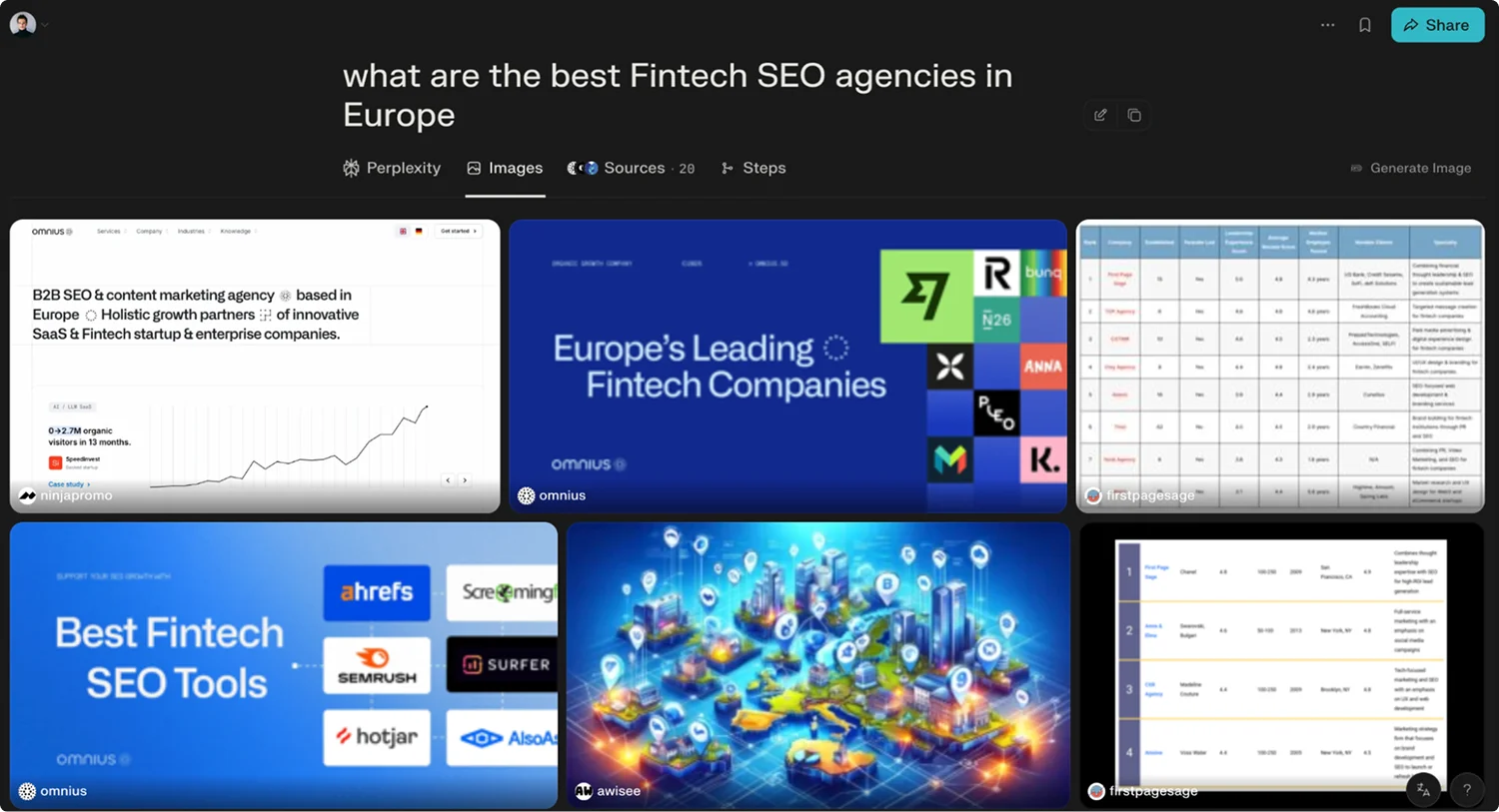
Synchronise video titles and descriptions with trending query phrases to capture cross‑platform momentum. Always brand visuals with your logo or watermark to reinforce authority.
8. Author Profiles & Citation Networks
Beyond domain authority, Perplexity pays attention to the individual author’s credibility. Include detailed author bios with links to professional profiles and prior publications.

Establish internal citation networks by linking to your own authoritative content and creating topic clusters. This signals comprehensive coverage and helps Perplexity see your site as a trusted hub.
9. Conversational Q&A Sections
Perplexity’s users often ask natural‑language questions rather than keyword strings. Incorporate Q&A sections within your articles that mirror how people phrase queries. Provide concise answers followed by deeper explanations and context.
Adding FAQ schema markup increases the likelihood that the engine will surface your answers.
Technical & Governance Requirements
Ensuring that Perplexity can crawl, parse and trust your content isn’t merely a matter of adding keywords, it requires careful technical setup and governance.
1. Robots Policies & Crawlability
Perplexity uses a declared crawler (PerplexityBot) and, according to its own documentation, respects robots directives. Decide whether to allow or disallow PerplexityBot and document that decision in your robots.txt. Maintain a “living” robots policy: test your directives, monitor server logs for misbehaving crawlers, and update policies as needed. The Cloudflare dispute shows that undeclared crawlers might access blocked sites; if your legal team requires strict adherence, set up Web Application Firewall (WAF) rules and audit access logs regularly.
2. Schema Markup & Structured Data
Implement schema markup to help the AI understand your content. Recommended types include FAQPage, HowTo, Article, Product, Author and Organization. For long‑form guides, define your content hierarchy with proper H1/H2/H3 tags and add FAQ or How‑To schema where relevant. Use clean, descriptive URLs (e.g., /perplexity-seo-guide-2025/ rather than /blog/post‑147 ) and ensure your HTML is machine‑readable.
Here’s the prompt you can use to create the FAQ schema markup - it’ll help you generate it in a second:
3. Core Web Vitals & Performance
Perplexity cares about user experience: page speed, mobile friendliness and Core Web Vitals remain important.
Keep Largest Contentful Paint (LCP) and Cumulative Layout Shift (CLS) within healthy ranges and minimise Time to First Byte (TTFB).

Fast, stable pages reduce bounce rates and improve engagement signals, which Perplexity monitors.
4. Clean HTML & Parsing
Use semantic HTML and avoid cluttered markup. Keep paragraphs short (2–3 sentences), break up content with lists and tables, and employ descriptive headings. Avoid hidden text or
intrusive ads that could confuse the crawler. Place important information near the top of the page so the model finds it quickly.
5. Localisation & Compliance
Tailor your content to local languages, currencies and regulations. If you operate across multiple jurisdictions, create region‑specific pages that address local tax rules, legal considerations and spelling variants. This improves relevance and ensures compliance with regulatory guidelines.
6. Governance & Experiment Design
For enterprise teams, treat Perplexity optimisation as an ongoing program:
Logging & Monitoring: Maintain logs of ranking model changes and updates. Annotate content updates and track when Perplexity visibility shifts; this helps correlate performance with algorithm changes.
Discover Monitoring: Watch Perplexity’s Discover pages and trending queries to time your releases. A sudden uplift or drop in engagement can signal model tweaks. Attribution & Commerce: If you sell products, prepare your product feeds and offer pages for assistant‑driven checkout flows. Coordinate with legal and payments teams to ensure brand safety and proper disclosures.
Experimentation: Treat each reported parameter, like new_post_impression_threshold or embedding_similarity_threshold , as a testable hypothesis. Run A/B tests on titles, release timings and link diversity. Use holdout groups to isolate what works and document results.
By combining robust technical foundations with disciplined governance, you ensure that Perplexity can access, interpret and trust your content. This sets the stage for the tactical optimisations and enterprise strategies we’ll cover next.
Optimisation Playbooks for 2025
Understanding Perplexity’s signals is only half the battle; you also need processes that operationalise them. Below are playbooks derived from the reported ranking patterns.
1. The New Post System: Winning the Launch Window
Perplexity reportedly applies early performance gates through parameters like new_post_impression_threshold and new_post_ctr . Pages that hit these thresholds in the first hours gain long‑term visibility, while those that don’t may never surface in Discover. To maximise your launch window:
Concentrate distribution – As soon as you publish, promote the article across email, social media, newsletters and internal channels.
Synchronise cross‑platform releases – If you have a YouTube channel or podcast, release a complementary video or audio episode with a title that matches the trending query.
Craft precise titles and intros – Align your page titles, H1 tags and opening paragraphs with the actual user intent to avoid “no‑click” impressions.
Test copy and previews – Run A/B tests on headlines and lead paragraphs to improve click‑through rate before you push the content to wider audiences.
2. Topic Multipliers & Portfolio Design
Perplexity assigns different visibility weights to topic categories. Parameters like subscribed_topic_multiplier , top_topic_multiplier , default_topic_multiplier and restricted_topics create large deltas in reach. High‑value topics reportedly include AI,
technology, science and business, while categories like entertainment and sports are restricted.
Prioritise high‑multiplier topics that align with your brand’s expertise.
Build a topical portfolio – Rather than betting everything on one category, map out a content calendar that covers high‑multiplier topics and diversifies within them (e.g., AI ethics, machine‑learning benchmarks, B2B automation trends).
Avoid restricted categories for SEO impact; if you must publish them, treat them as brand or thought‑leadership content rather than citation drivers.
3. Time Decay & Refresh Cadence
Perplexity’s Discover surfaces apply time decay through parameters like time_decay_rate and item_time_range_hours . Visibility drops quickly unless content remains timely.
Publish while the topic is rising – Use trend monitoring tools to spot emerging queries and release content early.
Refresh canonical pages – Add dated change logs and update sections as facts evolve. This signals recency and keeps pages eligible.
Stagger distribution – Rather than blasting all channels at once, spread your promotion across the launch window to sustain impressions.
4. Semantic Coverage & Embedding Quality
The embedding_similarity_threshold parameter means your content must semantically match the query and user context.
Use entity‑rich language – Include relevant terms, synonyms and related concepts to cover the intent comprehensively.
Avoid keyword stuffing – Focus on semantic coverage and factual correctness; stuffing keywords can lower quality scores.
Scope each page to one main intent – This improves alignment with user queries and supports the embedding gate.
5. User Engagement & Memory Networks
User interactions over the last week influence ranking. Reported metrics like discover_engagement_7d and historic_engagement_v1 track clicks, dwell time and other proxies. Additionally, interlinked “memory networks” can boost content when a user navigates through related pages.
Design for engagement – Write compelling subheads, include clear calls to action and add interactive elements (e.g., calculators, polls) to keep users on your page. Build content clusters – Link your pages contextually and add mini summaries when referencing other articles. Use consistent navigation elements so Perplexity can recognise the cluster.
Monitor dislikes and no‑click signals – If a page accrues negative feedback, revisit the title and intro or retire the piece.
By following these playbooks, you can align your publishing cadence and content strategy with Perplexity’s underlying mechanics, improving the odds that your pages will pass early quality gates, rank for high‑impact topics and remain visible over time.
Enterprise & Advanced Tactics
Beyond core optimisation, Perplexity’s ranking patterns introduce additional levers that large organisations can test and operationalise. These tactics address feed behaviour, domain diversity, trending dynamics and commerce readiness.
1. Feed Management & Content Diversity
Perplexity uses a persistent feed system with parameters such as persistent_feed_limit , feed_retrieval_limit_topic_match and persistent_feed_cache_ttl_minutes . These settings determine how many items appear per topic and how long they persist in user feeds.
Additional controls like diversity_hashtag_similarity_threshold and hashtag_match_threshold encourage topical variety and prevent spam.
Publish in windows when your audience is most active. Analyse engagement patterns and schedule releases accordingly.
Vary hashtags and tags – Use a small set of precise tags per article and vary them across your content cluster to avoid similarity penalties.
Avoid near‑duplicate pages – Consolidate overlapping content, canonicalise related pieces and clearly differentiate similar posts.
2. Domain Blending & Citation Diversity
The “blender” system reportedly limits the percentage of citations from any single domain, using parameters like blender_web_link_percentage_threshold and blender_web_link_domain_limit . To comply:
Cite multiple authoritative domains – Balance internal links with external references from high‑trust sources (e.g., academic journals, official documentation, reputable news outlets). Prefer primary sources – Where possible, quote official docs or research papers rather than summarised third‑party articles.
Monitor external link mix – Use dashboards to ensure no single domain consistently accounts for a disproportionate share of outbound links.
3. Query Suggestion & Trending Detection
Perplexity’s suggestion engine aggregates trending queries and clusters them into related sets. Configurable parameters control trending news indices, fuzzy deduplication and autosuggest behaviour.
Track trending topics – Regularly review trending indices and topic clusters. If a query spike appears, publish quickly with matching titles and summarised answers. Use fuzzy deduplication awareness – Recognise that Perplexity may merge similar queries into one cluster; tailor your content to address the broader topic rather than over‑optimising for minor keyword variations.
Diversify query coverage – Create evergreen pages for broad topics and shorter, timely posts for trending questions.
4. Commerce Readiness & Agentic Checkout
Perplexity’s partnership with PayPal and Venmo signals a move toward assistant‑mediated commerce. For ecommerce brands:
Prepare product feeds – Ensure product pages include structured data (price, availability, shipping details) and comply with PerplexityBot’s crawler guidelines.
Align with payment systems – Coordinate with legal, payments and compliance teams to ensure that on‑site checkout flows are safe, transparent and ready for integration.
Think beyond referrals – Recognise that in an agentic commerce flow, research, selection and payment may happen entirely within Perplexity; your content needs to serve as both product information and conversion funnel.
5. Governance & Continuous Experimentation
At enterprise scale, optimisation should be treated as an ongoing program rather than a one‑off project.
Maintain a model change log – Annotate each Perplexity ranking shift with the date, suspected algorithm update and affected pages.
Run holdout tests – Use A/B tests on titles, meta descriptions, release timings and link diversity to validate which factors have the greatest impact.
Coordinate cross‑functional teams – Align your SEO leads, data scientists and product managers to ensure that technical, content and business teams share insights and avoid siloed efforts.
By embracing these advanced tactics, managing feeds and diversity, preparing for assistant‑mediated commerce, and institutionalising experimentation, enterprises can stay ahead in a rapidly evolving AI‑first search landscape.
Measurement & Attribution
Optimising for Perplexity isn’t complete without robust measurement. Traditional SEO metrics like keyword rankings and page views are insufficient for AI‑first search. Instead, focus on metrics that reflect citation presence, user behaviour and topic authority.
1. Citation Tracking & Analytics
Perplexity does not currently provide native ranking reports, so you need to build your own visibility logs. Start by filtering GA4 traffic for sessions where the session source is perplexity.ai . Use Looker Studio to create widgets showing sessions, engaged sessions and conversions from Perplexity referrals. Complement this with a citation tracker: maintain a spreadsheet of Perplexity answer pages that cite your content, noting the query, the snippet used and the last update. Over time, correlate citation frequency with content updates and promotional efforts.



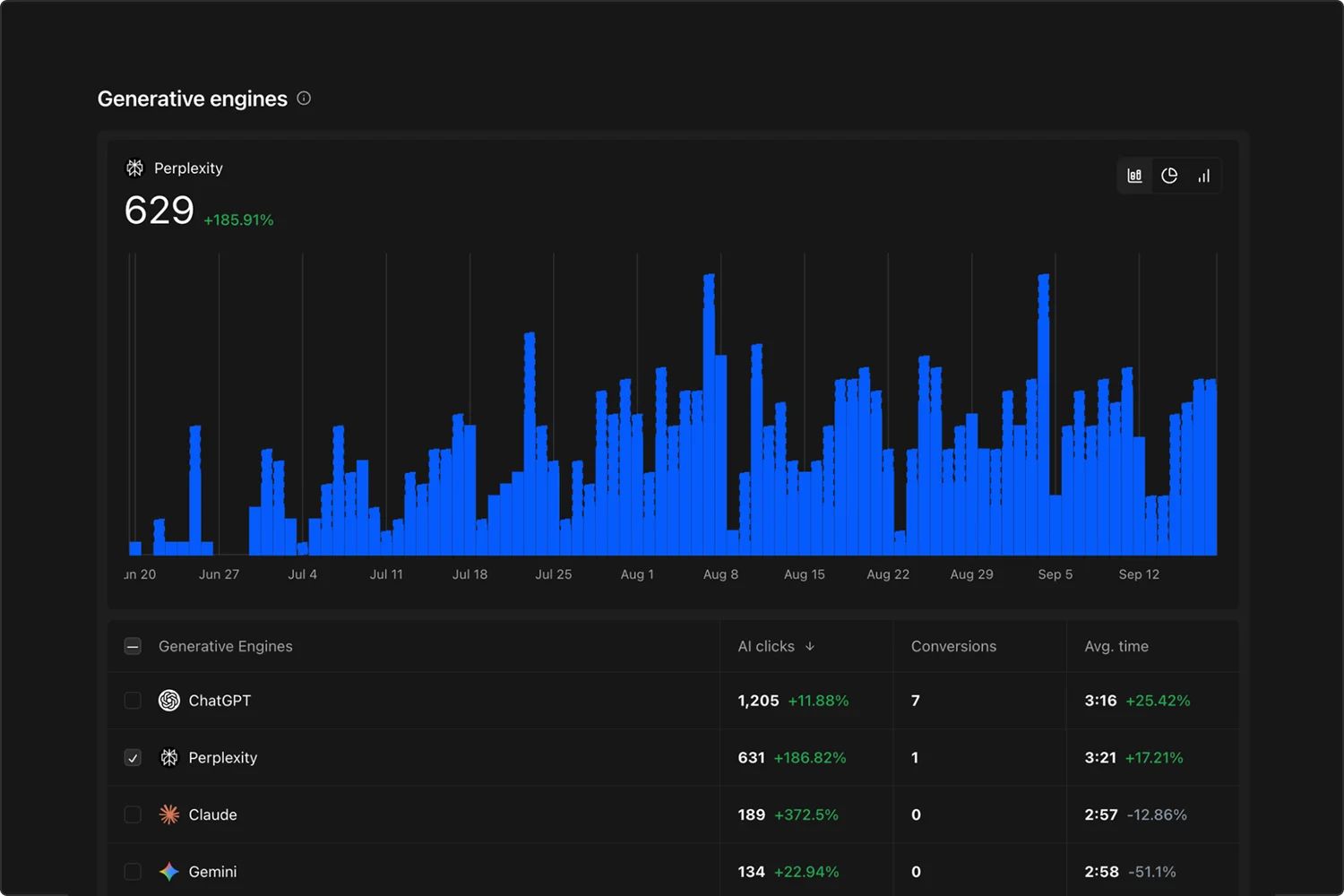
2. AI‑Specific KPIs
Claude proposes metrics tailored to AI search performance:
Citation Frequency – How often your pages are cited across Perplexity and other AI answer engines. Tools like Atomic AGI can monitor citations and alerts.
Branded Search Lift – Track increases in branded keyword searches on Google or other search engines; AI visibility often drives curious users to research your brand. High‑Intent Traffic Quality – Measure conversion rates, time on site and pages per session for users arriving from AI search.
Topic Authority Expansion – Monitor your citation footprint across adjacent topics; effective Perplexity optimisation often leads to citations beyond the initial keywords.
3. Model Change Logs & Experiment Tracking
Perplexity’s algorithm may change without notice. To isolate cause and effect:
Maintain a model change log – Record when new Perplexity product updates, industry news or algorithm rumours occur. Annotate your analytics data with these dates to identify correlations with ranking shifts.
Log content updates – Note the date and nature of each major edit, including schema additions, new data points or refreshed sections. Compare citation frequency before and after the update.
Run controlled experiments – Set up A/B tests on titles, intros, visuals, link diversity and release timings. Keep a clear record of control and variant performance.
Mistakes to Avoid
Even well‑intentioned optimisation efforts can backfire if they overlook Perplexity’s unique dynamics. These are the most common mistakes documented in your sources.
Mass AI‑Generated Content
Some companies publish thousands of generic AI‑generated articles to “scale” content. This approach has backfired spectacularly: one example saw 99.3% of their Google traffic vanish after a mass‑publish penalty. Perplexity’s algorithms are even better at detecting low‑quality, generic output. Avoid quantity over quality. Instead, invest in fewer, higher‑authority pieces with unique data and expert insight.
Keyword‑First Thinking
Optimising for specific keywords misses the point. Perplexity processes conversational and context‑heavy queries, so focusing narrowly on single keywords can degrade semantic relevance. Emphasise topics, concepts and entity‑rich language rather than keyword stuffing.
Neglecting Author Credibility
Anonymous or low‑credibility authors hurt citation probability. Always include detailed author bios, highlight professional expertise and link to other published work. For corporate blogs,
assign topics to recognised subject‑matter experts rather than generic “team” bylines.
Generic Industry Content & Thin Advice
Perplexity favours specific, actionable insights over generic best practices. Avoid thin content that merely regurgitates popular advice. Instead, provide original research, case studies and unique frameworks.
Ignoring Negative Signals & User Feedback
Failing to monitor dislikes or no‑click impressions can suppress a page’s visibility. If a page accrues dislikes or persistent no‑click behaviour, revisit the title and introduction, clarify the content or consider retiring the piece. Similarly, ignoring time‑decay dynamics and not refreshing content will cause it to drop out of Discover.
Overreliance on a Single Domain or Source
Citing only your own domain or one external source triggers Perplexity’s domain blending controls. Diversify outbound links and include multiple authoritative domains. This not only improves ranking but also demonstrates balanced research.
Skipping Technical Compliance
Neglecting robots directives, schema markup or Core Web Vitals diminishes crawlability and user experience. Similarly, failing to localise content or comply with regional regulations undermines authority. Technical debt in these areas can outweigh great content.
Avoiding these pitfalls will help ensure your optimisation efforts translate into meaningful citations and sustained visibility.
The conclusion
Perplexity SEO represents more than just another optimisation tactic; it’s a fundamental shift in how information is discovered and consumed. As AI answer engines proliferate, citations become the currency of visibility, replacing the blue‑link hierarchy we’ve known for decades. Early movers who invest in authoritative, evidence‑rich, well‑structured content will occupy a privileged position in these answer cards, capturing the attention of high‑intent researchers and decision‑makers.
Looking ahead, optimisation for Perplexity often translates to improved performance on other AI platforms such as ChatGPT, Claude and Gemini. This cross‑platform synergy means that efforts you make today, building author authority, publishing unique research, adopting structured formats, will compound across multiple channels.
Conversely, failing to adapt may leave your brand invisible in environments where citations are limited and competition is fierce.
The window of opportunity is closing quickly. With billions of AI prompts each day and growing adoption among professionals, the brands that master Perplexity SEO now will shape tomorrow’s knowledge landscape. Begin by auditing your existing content for citation worthiness, implement the formats and technical standards outlined here, and commit to continuous experimentation and measurement. In doing so, you’ll not only secure Perplexity citations but also position your organisation at the forefront of AI‑driven discovery.
This is your moment to lead the AI search shift - partner with Omnius to build authoritative, citation-worthy content that keeps your brand visible and trusted.
Keep Learning
How to Rank in Google AI Overviews with 8 Actionable Steps?
How to Rank on ChatGPT: 6 Tips to Boost AI Visibility
How to Rank in AI Search Results in 2025? [Actionable Guide]



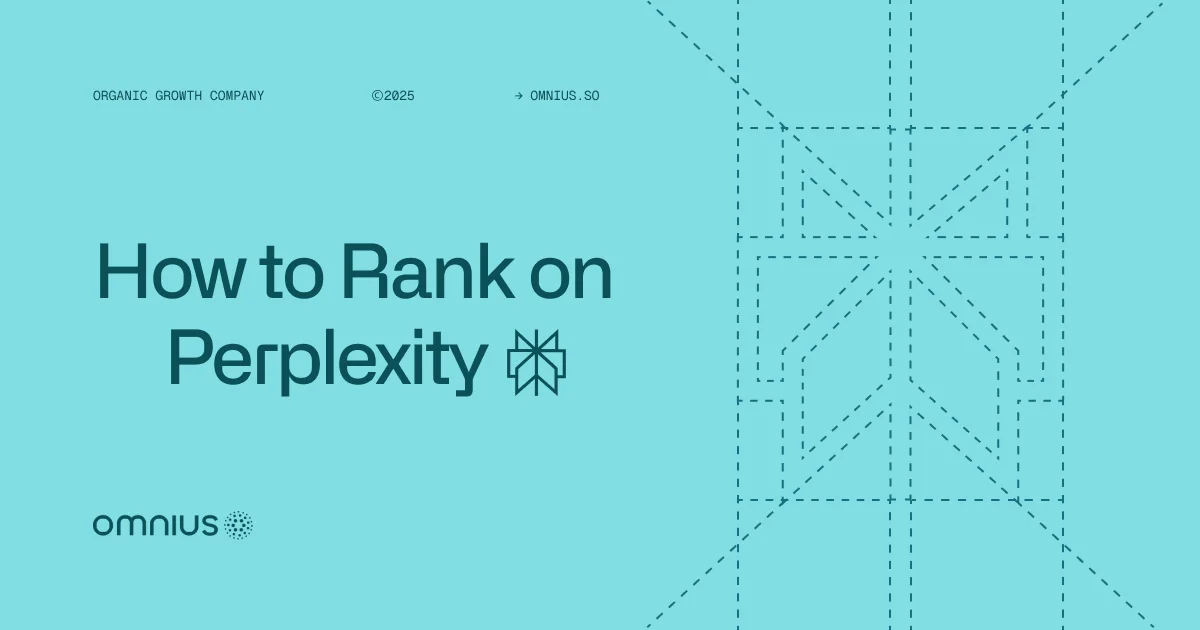





.png)

.svg)








.svg)














.png)

.png)


